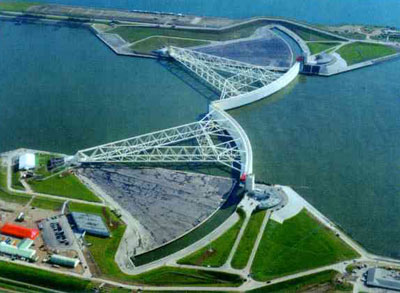
Over the past 20 years, it has become plainly clear that storm strength has been increasing. Whether you blame global warming, climate change, natural variation in global temperatures over time, or just think it’s a coincidence, larger, more powerful storms have become the norm. And the value of development in the path of those storms has increased, as well. In New York City alone, damage from Hurricane Sandy is expected to exceed $18 billion, and damage to Long Island and New Jersey figure to increase the damage to over $50 billion. On the heels of Hurricane Irene in the summer of 2011, which cost the New York Metropolitan Area (New Jersey in particular) around $15 billion, and Hurricane Katrina which caused a still largely-unpaid $125 billion in damages, it is apparent that a new storm protection system is necessary.
In the wake of Hurricane Irene, Columbia University published a study stating that if the storm surge had been only one foot larger, it would have “paralyzed lower Manhattan.” Hurricane Sandy was one foot higher, and guess what? It definitely paralyzed lower Manhattan. The natural barriers to flooding and storm surges like marshes, swamps, large sand dunes, and unoccupied barrier islands have been attenuated by human and commercial development, and while it would be interesting to bring some of those natural protection systems back, it is probably more feasible to develop a storm surge system in the New York Harbor or Atlantic Coast. While it would undoubtedly be expensive to create such a system, the cost of such infrastructure must now be squared against the ever-increasing potential costs of future storms. The idea of a storm protection system for the New York Metropolitan area is nothing new, and in the wake of the storm there have been proposals with cost estimates less than the estimated combined damage of Hurricanes Irene and Sandy. At some point, New York must accept the same realities that its former Dutch owners have incorporated into their infrastructural urban reality.

Since we have destroyed our own first nature flood protection systems, we must recognize the importance of new second nature storm protection systems within or around the Harbor. After all, the cost of the damages from each succeeding storm could have gone towards the cost of preventing future damages. Ultimately, if increasingly strong storms have become the norm, it is the duty of policy makers to design increasingly innovative and equally strong systems of protection to prevent the kind of damages we all saw this past week.
For a continuation of the discussion about potentially building sea gates in NYC, check out the NYTimes‘ “Room for Debate” page, including a contribution from our adviser, the director of the CUNY Institute for Sustainable Cities, Bill Solecki. And check out another interesting piece from the Observer on why NYC should follow the Dutch and build a sea gate.